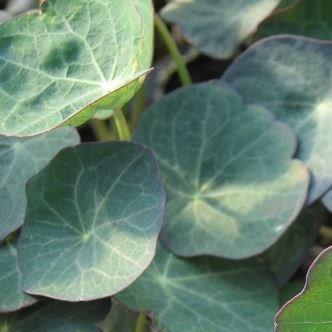
Tropaeolum Majus 'Blue Pepe'
Nasturtium 'Blue Pepe'
A compact, clump forming, bushy annual, the 'Blue Pepe' has small edible blue-green leaves with edible bright red flowers held above.
Contributed by @anddh
-
Full sun
-
Occasional watering
-
A little frost hardy: 32F (0°C)
-
All soil conditions
Common name
Nasturtium 'Blue Pepe'
Latin name
Tropaeolum Majus 'Blue Pepe'
type
Annual
family
Tropaeolaceae
ph
5.0 - 7.0 Acid - Neutral
Plant & bloom calendar
-
Best time to plant
-
When the plant will bloom
full grown dimensions
 1.50 M
0.50 M
1.50 M
0.50 M
Tropaeolum Majus 'Blue Pepe'
A compact, clump forming, bushy annual, the 'Blue Pepe' has small edible blue-green leaves with edible bright red flowers held above.
Flowering Season
From Early Summer TO Early Autumn
Orange or yellow flowers appear from early Summer to early Autumn
Planting
From Mid Spring TO Late Spring
Sow seeds 3/4 of an inch deep in mid to late Spring at the flowering site
Propagating
From Early Spring TO Mid Spring
Nasturtiums self-seed very readily, and flowers allowed to go to seed will drop seed that will grow readily the following Spring. Can also be sown in seed trays - fill a seed tray with seed compost,water and allow to drain.Sprinkle seeds over the surface allowing roughly 25mm space between seeds and cover with a thin layer of compost. Put tray in a clear polythene bag and place on a windowsill. When seedlings show remove plastic bag.When the second pair of leaves appear on the seedlings thin out to 50mm spacing by removing the weakest looking plants.After 2 or 3 weeks and when danger of frost has passed plants can then be planted outside into required position.








